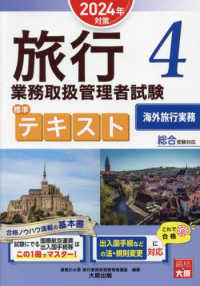- ホーム
- > 洋書
- > 英文書
- > History / World
Full Description
Trees were of fundamental importance in Anglo-Saxon society. Anglo-Saxons dwelt in timber houses, relied on woodland as an economic resource, and created a material culture of wood which was at least as meaningfully-imbued, and vastly more prevalent, than the sculpture and metalwork with which we associate them today. Trees held a central place in Anglo-Saxon belief systems, which carried into the Christian period, not least in the figure of the cross itself. Despite this, the transience of trees and timber in comparison to metal and stone has meant that the subject has received comparatively little attention from scholars.
Trees and Timber in the Anglo-Saxon World constitutes the very first collection of essays written about the role of trees in early medieval England, bringing together established specialists and new voices to present an interdisciplinary insight into the complex relationship between the early English and their woodlands. The woodlands of England were not only deeply rooted in every aspect of Anglo-Saxon material culture - as a source of heat and light, food and drink, and wood and timber for the construction of tools, weapons, and materials - but also in their spiritual life, symbolic vocabulary, and sense of connection to their beliefs and heritage. These essays do not merely focus on practicalities, such as carpentry techniques and the extent of woodland coverage, but rather explore the place of trees and timber in the intellectual lives of the early medieval inhabitants of England, using evidence from archaeology, place-names, landscapes, and written sources.
Contents
List of illustrations
1: Michael D. J. Bintley and Michael G. Shapland: An Introduction to Trees and Timber in the Anglo-Saxon World
Timber in Anglo-Saxon building practice
2: Michael G. Shapland: Meanings of Timber and Stone in Anglo-Saxon Building Practice
3: Mark Gardiner: The Sophistication of Late Anglo-Saxon Timber Buildings
4: John Baker: References to Timber Building Materials in Old English Place-Names
Perceptions of Wood and Wooden Objects
5: Martin G. Comey: The Wooden Drinking Vessels in the Sutton Hoo Assemblage: Materials, Morphology and Usage
6: Jennifer Neville: The Exeter Book Riddles' Precarious Insights into Wooden Artefacts
7: Michael D. J. Bintley: Brungen of Bearwe: Ploughing Common Furrows in Exeter Book Riddle 21, The Dream of the Rood, and the Æcerbot Charm
8: Pirkko Koppinen: Breaking the Mould: Solving the Old English Riddle 12 as Wudu 'Wood'
Trees and Woodland in Anglo-Saxon Belief
9: Clive Tolley: What is a 'World Tree', and Should We Expect to Find One Growing in Anglo-Saxon England?
10: John Blair: Holy Beams: Anglo-Saxon Cult Sites and the Place-Name Element Beam
11: Michael D. J. Bintley: Recasting the Role of Sacred Trees in Anglo-Saxon Spiritual History: the South Sandbach Cross 'Ancestors of Christ' Panel in its Cultural Contexts
12: Della Hooke: Christianity and the 'Sacred Tree'








